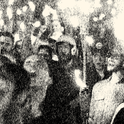Driving through the monotonous desert that connects Yemen’s eastern provinces to the country’s northern highlands, the only break in the road as it heads towards a liquefied mirage are rusting oil barrels and makeshift wooden huts that mark the regular checkpoints dotted along the tarmac. Fuel tankers, food trucks and cement lorries pause as drivers hand bundles of green and yellow Yemeni rial notes out of their windows to scruffy soldiers. While government employees, from medical practitioners to street cleaners, continue their wait of more than a year for unpaid salaries, and while millions face starvation, these wads of cash fuel a war economy that is proving highly lucrative for some.
This war is at once head-spinningly complex in its causes and brutally simple in its human consequences. It began in September 2014 after so-called “Houthi” rebels, allied with Yemen’s former president, Ali Abdullah Saleh, took control of the capital, Sana’a. Saleh’s successor, President Abdrabbuh Mansur Hadi, fled to Saudi Arabia six months later. The Saudis then intervened on Hadi’s behalf, beginning daily bombing raids and leading a multinational coalition of forces. By the end of 2016 it had cost a conservatively estimated 10,000 civilian lives, and forced some three million people to flee their homes. It is now the world’s worst humanitarian crisis—worse even than Syria.
After the twists and turns of the near three-year-long war, on 5th December the wily former president, Saleh, became one of the victims of a conflict he had masterminded. He was killed by Houthis just days after splitting from the movement. This is a war of unstable alliances on the ground, and also one that involves an extraordinary range of nations and nationalities. The Saudi Arabia-led coalition includes Bahrain, the UAE, Morocco, Kuwait, Egypt, Jordan and, until a recent diplomatic spat, Qatar. Sudan, Senegal and Eritrea are also involved—Sudan has supplied the infamous Janjaweed militia, notorious for ethnic cleansing in Darfur. They are supporting thousands of Yemeni ground troops trained in Saudi, Eritrea and the UAE.
Then there is Britain. Along with the United States, we are tacitly giving backing to the campaign, including logistical support in Saudi’s command and control centre, albeit separated by a glass wall to provide deniability that we are “in the room.” Britain (like the US) has also continued to sell arms to Saudi Arabia, which are being used on the battlefield. Britain has licensed the sale of £4.6bn worth of arms to Saudi since its intervention in Yemen’s war began—more than double the value of licensed sales to the kingdom in the corresponding previous two years. Two parliamentary select committees have called for these sales to be halted, as has Jeremy Corbyn.
The government, though, sees no problem. As the Foreign Secretary Boris Johnson put it, “if we don’t sell arms to Saudi Arabia, someone else will.” He insists the threshold of the Arms Trade treaty—that precludes the sale of weapons in cases where there is a risk they will be used in violations of international humanitarian law—has not been crossed in Yemen. Human rights groups disagree. In November, Theresa May turned up in Riyadh and suggested it might be humane to ease the blockade on Yemen. But seeing as the principal and publicly-stated purpose of the trip was to drum up demand for Brexit Britain’s exports, of which arms sales are a major component, her words struck a hollow note.
Britain can whimper about the consequences of this bloody dispute, but it cannot credibly dispute it has thrown its lot in with the Saudi side. Not only that but the involvement of Eritrea in the Saudi coalition as well as the Sudanese Janjaweed—officially fighting as part of Sudan’s Rapid Support Forces—places Britain on the same side as a government it accuses of savage human rights abuses (Eritrea) and a regime and militia it accuses of genocide (Sudan). And the plot thickens further. In parts of the country ultra-religious Salafist militias—created and armed by Saudi and the UAE—have joined Hadi’s new army. Al-Qaeda’s domestic insurgents in Yemen, known as Ansar al-Sharia, have also benefited from Saudi coalition weaponry, and boast in propaganda statements of their role in fighting the Houthis on the frontlines.
Britain, then, finds itself on the same side as an offshoot of al-Qaeda. And how are Britain’s effective allies conducting this war? From evidence I have gathered, since March 2015 they have repeatedly, if not systematically, targeted civilians and civilian infrastructure indiscriminately. The rest of the world tries to make sense of Yemen as a crucible for far wider religious tensions and regional rivalries. It is painted as a proxy war between the confessionally opposed Sunni Kingdom of Saudi Arabia and Shia Iran, or—alternatively—as a David vs Goliath war of the region’s richest nation bombing the poorest.
Both narratives capture something of the conflict. But this civil war is, at its heart, a home-grown struggle between two rival Yemeni elites, tussling over money, resources and control of a fracturing state. Many of the roots of this nation’s agonies lie in its own distinctive soil.
***
Yemen’s current war may have only begun in 2014, but its origins go much further back. As so often in the Middle East, Empire cast a long shadow. Britain became involved in Aden, on the south coast of what is now Yemen, when looking for a coal depot to service steam ships en route to the Raj. London ended up, as in so much of the Empire, jostling with other big powers in the region and local players who carried weight on the ground, casually drawing up borders between sultanates and emirates in a land it did not understand. As so often, again, it eventually beat a retreat from the region, leaving chaos in its wake.
In the 1960s, the North, which had long been a separate state, endured a civil war and eventually took an Arab nationalist turn, while the South became a Marxist “People’s Republic,” fully aligned to the Soviet bloc. There was ongoing tension between the two through the 1970s, as well as domestic instability, when in 1978 Ali Abdullah Saleh, a junior officer who served in Yemen’s Tank Corps in the 1960s, was elected by parliament as president of North Yemen. Few expected him to last, in office or indeed at all. Two of his three predecessors had been assassinated in the nine months before he came to power. Yet Saleh’s skills in manipulation kept his enemies at bay, via a patronage network stretching through the army, tribes and businessmen.
His state absorbed the South after the Communist collapse of 1989-90, initially through agreement, although within a few years the army was putting down separatists by force. Opposition parties were allowed under Saleh’s rule, but it would be a stretch to describe the nation as democratic. Yemen’s constitution was notionally based on Islamic law but much of it was never enforced or implemented. In an increasingly conservative Muslim society, Saleh and his General People’s Congress Party were viewed very much as moderate or even liberal, especially compared to the Saudi-sponsored Salafism that spread in Yemen from the 1970s on.
Developing a centrally controlled black economy became Saleh’s master craft. During 33 years in power—which ended in 2012—Saleh squirrelled away some $60bn. According to a 2015 UN report, his family and associates stole from the country’s fuel subsidy programme and indulged in “abuse of power, extortion and embezzlement.” Unsurprisingly, the profits from the country’s relatively small, but economically essential, oil revenues were not seen by the local communities where natural resources were extracted. There was often disquiet, manifested—for example—in the Southern Movement, or al-Herak al-Janoubi, formed in 2007 as a peaceful political group, who carried out street protests and civil disobedience.
Meanwhile, in the north, Zaydis—a branch of Shia Islam almost unique to Yemen—formed a revivalist group, headed by Sheikh Hussein Badreddin al-Houthi. He died in 2004 but his name is informally applied to the movement that today is vying for control of the capital. Officially called Ansar Allah (Partisans of God), the Houthis fought six wars with Saleh’s state forces between 2004 and 2010.
The Saudis eventually got involved, making airstrikes for the benefit of Saleh’s side. By December 2010, political tensions were rising. Yemen’s coalition of opposition parties boycotted parliament in protest. After revolutions tore through Tunisia and Egypt in early 2011, Saleh’s opponents seized their chance, and capitalised on the groundswell of dissatisfaction among the youth who account for over 60 per cent of Yemen’s population. After nine months of protests, crackdown and eventual gun battles, Saleh was forced to hand over power to his long-standing Vice President, Abdrabbuh Mansour Hadi. In February 2012, Hadi was elected as president for a supposed fixed term of two years. His name had been the only one on the ballot paper.
At this stage, as the naive optimism of the Arab Spring gave way to cynicism about democracy, the “Yemen model” of passing on the baton of leadership through a utopian National Dialogue Conference was rather admired in the west. It was pointed to as an example for other nations, notably Libya, to follow. Yet in the two years that followed, the UN-facilitated transition faltered, and failed to resolve the big issues, most notably the growing calls from regions and factions for autonomy. Amid disputes about how federalism might work, cuts to fuel subsidies and the nagging sense that Hadi’s government was even more corrupt than his predecessor’s, both the Houthis and Saleh—who spent the years of transition preparing for war, rather than dialogue—both spotted their chance.
In September 2014 the Houthis ostensibly seized control of Sana’a. Yet it soon became obvious that there was a guiding hand behind their coup: none other than the Houthis’ long-term foe, former president Saleh, who was ready to forge all kinds of unlikely alliances as he sought revenge those who had displaced him. Despite leaving office, Saleh had retained loyalists across government and, crucially, within the armed forces. Without a shot being fired, government buildings, including the parliament and Ministry of Defence, were handed over.
Saleh loyalists in the military morphed into “Houthis” overnight. The day after the Houthis moved into Sana’a, I spoke to a shop manager in a plush shopping district warily watching the rebels park up next to his business, with their anti-aircraft gun mounted on a pick-up truck. “We know all of them. They’re all Saleh’s men,” he said with a shrug. Six months later Saleh’s troops, alongside the Houthis, fought their way into Aden, where Hadi had initially fled, and sent him running for his life to Saudi Arabia.
Days later on 26th March 2015 the Kingdom, along with a rapidly created coalition of regional nations, launched Operation Decisive Storm—a bombing campaign aimed at reinstating Hadi and pushing back the Houthis. The ensuing conflict revived old divisions. Southerners, with a long-held hatred for Saleh that had festered since the last North-South civil war of 1994 (which ended in a crushing defeat for the former socialist state), welcomed Saudi’s intervention, although few held Hadi in high esteem. Southern secessionist leader, Aidarus al-Zoubaidi, emboldened by support from the UAE—who now hold greater sway over southern Yemen than president-in-exile Hadi—announced the establishment of a rival ruling council this May followed by a parliamentary body in October, the latest attempt to reverse the 1990 unification.
All this history matters because it greatly complicates the task of putting the country back together again. The loose alliance between Saleh and the Houthis was so nakedly opportunistic that it was never expected to last. In late November, clashes over control of Sana’a’s largest mosque—built by and named after Saleh—deteriorated into street battles between Saleh’s men and Houthi fighters. As Saleh switched direction and called for a nationwide unified fight against the Houthis, the Saudi coalition and (still exiled) official Yemeni government quickly offered support. But it was a grave miscalculation by Saleh: his loyalists were unable to gain the upper hand.
For the coalition, the split appeared to offer a way out of the conflict, one that died with Saleh, who was killed by Houthi fighters while apparently fleeing the capital. The tribes surrounding Sana’a—that Saleh had manipulated for so many years—failed to rally around him when he needed them most. The game of playing opponents off against each other that he had played so well was ultimately the game he died by. The next question becomes whether the Houthis can maintain their grip on the capital and the country now that they have killed the great string-puller.
***
Yemen’s war has shattered the social fabric of its 27m-strong population and devastated its infrastructure. It is a land seared by division. The flat eastern desert is controlled by the exiled Hadi government, the more populous northern highlands by the fraying Houthi alliance. The US and UK-backed Saudi-led coalition have restricted imports into the lifeline port of Hodeidah on Yemen’s western coast under the pretext of preventing Iranian weapons shipments reaching the Houthis. In November, that blockade prevented the country from receiving all humanitarian aid or assistance for two weeks.
In peacetime, Yemen imported around 90 per cent of its food. Cut that off and the consequences are as preventable as they are dire. The violence may have directly killed thousands, but hundreds of thousands more have died from lack of food and medicine. In 2016, Unicef estimates that one Yemeni child died every 10 minutes from malnutrition and preventable disease: 52,560 child deaths a year. Two-thirds of the population is in need of humanitarian aid. A cholera outbreak has surpassed the most pessimistic predictions of aid agencies and is projected to reach one million cases by the end of the year, killing more than 2,000 in what the UN describes as an “entirely manmade catastrophe.”
Looking ahead, more than seven million people face famine. On the battlefronts, the conflict has been in stalemate for months. The Saudi coalition made notable gains in the south back in the summer of 2015, UAE-backed militias, who they later trained up into a formal standing army, pushed the Houthi-Saleh forces out of Aden. Since that August, however, few significant gains have been made by either side.
This quagmire benefits those in the business of war. There are, for example, northern tribes who are taking money from both sides, turning the conflict into a bidding war. There are smugglers, gun runners and weapons manufacturers for whom the status quo suits; these people are, arguably, now the greatest barrier to any political resolution to the conflict. And there are also many militiamen who—in the absence of government wages—have little choice but to fight to earn a living. Different parts of the elite who established themselves under more than three decades of Saleh’s rule are today placed by the conflict, in theory at least, on opposing sides. Yet the economics of the war unites their interests—the well-connected on both sides are financial beneficiaries of the protraction of conflict, and the wages of corruption that come with it.
But the conflict has been economically ruinous for ordinary Yemenis. The price of goods combined with the lack of jobs mean many simply cannot afford food, which has become as much as 60 per cent more expensive. “Taxes” imposed by soldiers, militiamen and random gunmen who set up checkpoints every few miles on major roads are a big part of the reason why. At each stop, lorry drivers are forced to hand over cash, the cost of which is eventually passed on to the ordinary and increasingly-hungry consumers.
Saudi Arabia is pouring funds into this war because of its strategic interests. First, there is the obsession with Iran—Riyadh simply cannot countenance that country getting a foothold on the Arabian Peninsula. Then there is also the issue of saving face. This conflict is now inextricably linked with the ascendant Crown Prince, the 32-year old Mohammed bin Salman, who is trying to consolidate his power both at home and abroad. In recent months, he has launched an extraordinary crackdown, detaining more than 200 people, including princes and billionaires, on charges of corruption. As the Crown Prince continues to close down rival power centres, he sorely needs an extraction plan in Yemen which has at least the appearance of “winning,” even if it is a deceptive one. Finally, the conflict provides a rallying point for Saudi citizens to cement a sense of nationalism at a time of internal change.
***
The gulf between Yemen’s people and its politicians, the haves and the have nots, has never been wider. While Hadi’s internationally-recognised government continues to split and shuffle between other regional capitals, the capital’s airport was closed to civilian traffic by Saudi Arabia (who control the airspace) last year. An estimated 10,000 people are thought to have died as a result of not being able to fly out of the country for medical care.
The founder of Yemen’s humanitarian organisation Red Crescent, 76-year-old Abdullah Alkhamesi, became one of the casualties himself in August. Unable to find the supplies for a heart operation, he refused to use his connections to access life-saving treatment abroad. While civilians on both sides of the front face a daily struggle for food and water, ministers in the (official but exiled) Yemeni government attended a public gathering in Cairo to celebrate Eid in the first week of September. One bold Yemeni among the crowd stood up and jeered at the government officials. “The people are without salaries and electricity and you are sitting here? Enough! Go home!”
The parties to the conflict are myriad, but all are united by a lack of concern for civilian life. Having reported from two cities besieged by the Houthi/Saleh forces since the war began, I have witnessed truckloads of food supplies that should have been headed for starving civilians being turned back at checkpoints. I have seen Houthi gunmen seizing water that civilians were trying to get to their families inside the enclave of the central city of Taiz. I watched gun-toting Houthi fighters bellow at a female doctor, who was later arrested, for taking dialysis drugs and equipment into areas under siege in Aden.
The Saudi-led coalition has shown no more compassion. It has imposed crippling import restrictions on the most densely-populated north that lies under Houthi control. They have provoked David Beasley, Executive Director of the UN’s World Food Programme, into a statement of rare boldness for a bureaucrat. “Saudi Arabia should fund 100 per cent [of the needs] of the humanitarian crisis in Yemen,” he said in September. “Either stop the war or fund the crisis. Option three is do both of them.”
But how to draw a line? Focusing on regional political dynamics, or even the Yemeni elite, will not on its own achieve a durable end to the conflict. The disparate grievances of all the factions and tribes involved must be attended to—grievances that have built up over decades of corruption, oppression and marginalisation. To achieve a comprehensive end to the war, the UN-led efforts need to be broadened to include all the issues that lead to conflict. The current format for negotiation deals only with the Houthi alliance and their opponents: Hadi and the Saudi-led coalition. Any deal that emerges from this framework could easily repeat the mistakes of the 2011 transition deal—by fixating on the factions within the old elite at the expense of broader issues like the southern question and federalism, something which will be needed to check the deep-seated concerns about the overmighty control of central government.
An enduring solution would also need to find ways to tackle the corruption that has become a way of life under decades of dictatorship and now years of war. Sadly, an international community exhausted by conflicts in Syria and Iraq is not in a mood to engage in the complexities of Yemen’s war. With Donald Trump’s hollowing out of the US State Department the capacity to grapple with this conflict is further weakened. Add to that Trump’s enthusiastic embrace of Mohammed bin Salman in Riyadh, while using increasingly hostile rhetoric towards Iran, and the American president is at risk of extending the devastating war, notwithstanding his recent call for an end to the Saudi blockade.
The legacy of the fighting will be felt for generations to come. Not only as the impoverished country somehow attempts—eventually—to rebuild its infrastructure, and as families seek to avenge the dead in a never-ending cycle of violence; but also in the psychological and physical inheritance of severe malnutrition on a generation of children. I have met families displaced by the war who were eating trees to survive in the dusty scrublands of remote rural Taiz, and dug out American-made bomb remnants from an airstrike on a civilian house that killed two children. I know that civilian lives matter little to the war profiteers. As long as they are able to reap the benefits of continued conflict it seems unlikely they will have the inclination to end it.













